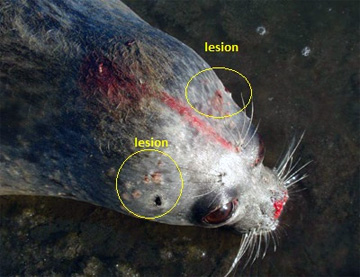
No Cause Identified for 2011 Northern Pinnipeds Unusual Mortality Event
February 22, 2014
Beginning mid-July 2011, elevated numbers of sick or dead seals with skin lesions started being discovered in the Arctic and Bering Strait regions of Alaska. The North Slope Borough Division of Wildlife Management first began to notice sick seals while conducting ice seal satellite telemetry studies during routine research in July and August 2011. Hunters also began to report unusual symptoms they were observing in seals during harvests. Although abnormal hair loss (known as alopecia) had been under investigation in ringed seals for several years, hunters and researchers started seeing seals with more severe signs of illness, as well as dead seals. Diseased seals--primarily ringed seals—exhibited hair loss, delayed molting, and skin ulcers. Some of these seals also exhibited lethargy and labored breathing. Similar cases in ringed seals were also reported from Canada and Russia. In addition, there have been some reports of skin lesions in Pacific walruses (Odobenus rosmarus divergens) in Alaska, with some associated mortality. Spotted seals and bearded seals were also affected. There were reports of pinnipeds with similar symptoms in Canada, Russia, and Japan. By December 2011, there were more than 100 cases of affected pinnipeds in Alaska’s Arctic region. Due to the unusual number of marine mammals discovered with similar symptoms across a wide geographic area, and after consultation with the Working Group on Marine Mammal Unusual Mortality Events, NOAA and USFWS announced the declaration of an Unusual Mortality Event on Tuesday, December 20, 2011. The declaration triggered a focused, expert investigation into the cause of the disease. An investigation team was established involving national and international specialists from numerous agencies, laboratories, and institutions, and including Tribal leaders, hunters, scientists, veterinarians, wildlife biologists, and disease diagnosticians from Alaska and beyond. This was the first Unusual Mortality Event involving subsistence species in coastal Alaskan communities. The investigative team worked closely with the State of Alaska Division of Public Health to assess potential risk and distribute general precautionary guidelines around handling and consumption in the absence of a known pathogen. Throughout the event, hunters have been encouraged to use traditional and customary practices when dealing with healthy and/or sick seals. There was no evidence that consuming animals involved in this disease event has caused any human illness. As of February 2014, no specific cause for this disease has been identified. Scientists consider multiple stressors in the environment to be contributing factors to the disease. Disease surveillance efforts in 2012 and 2013 indicate the disease event has ended. No new cases similar to those observed in 2011 have been discovered. Scientists say some seals which are likely survivors of the disease are still exhibiting patchy alopecia. Hunters can expect to continue to see hairless seals in spring 2014, particularly in the subadult age group. Test Results To date, numerous tests for viral, bacterial pathogens, and biotoxins have been performed. Despite extensive laboratory analysis, no specific disease agent or process has been identified. According to NOAA Fisheries, this may suggest that the underlying cause of this disease is most likely complex, involving a variety of factors. The following disease agents, some of which cause ulcerative skin disease in marine animals, have been screened for and ruled out as possible causes: Calicivirus, Morbillivirus, Pan-Picornavirus, Herpesvirus, Papillomavirus, Poxvirus, Parapoxvirus, Vesicular Stomatitis Virus, Foot and Mouth Disease, Circovirus, Influenza A/B, Arterivirus, Adenovirus, Coronavirus, Enterovirus, Flavivirus, Orbivirus, Orthohepadnavirus, Paramyxovirus, Rhabdovirus, and Papovavirus. Testing continues for a wide range of possible factors in this disease, including immune system-related diseases, fungi, man-made and bio-toxins, radiation exposure, contaminants, and stressors related to sea ice change. Preliminary radionuclide testing conducted by the University of Alaska Fairbanks found radiation levels within the typical background range. Scientists are investigating the possibility that radiation could have been one of many factors that contributed to the illness in these animals.
Edited by Mary Kauffman, SitNews
E-mail your news &
photos to editor@sitnews.us
|
||||
